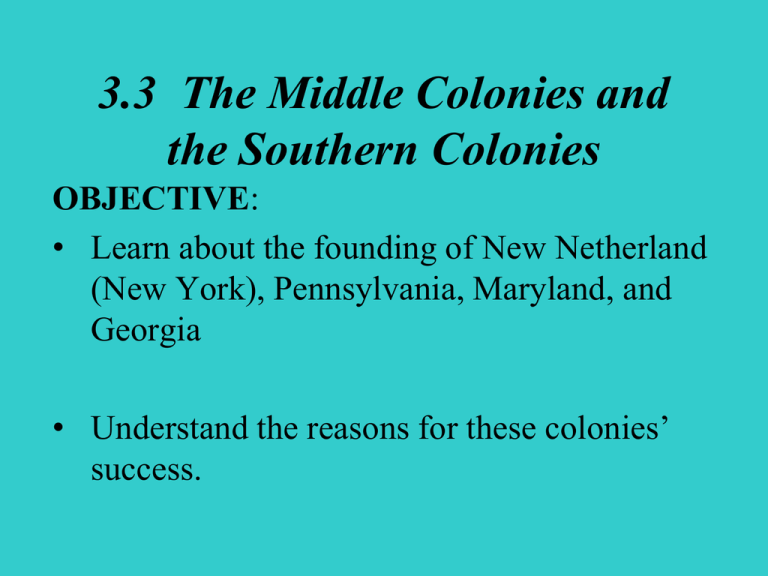
3.3 The Middle Colonies and
the Southern Colonies
OBJECTIVE:
• Learn about the founding of New Netherland
(New York), Pennsylvania, Maryland, and
Georgia
• Understand the reasons for these colonies’
success.
1. The Dutch colonies were known as New
_________.
2. The founder of Rhode Island was
___________________.
3. Pennsylvania was founded by _______.
4. Anne _________ was expelled by the
Puritans for being a religious dissenter.
The modern city of New _______ was
originally known as New Amsterdam.
5. Pennsylvania was founded by _______.
1. The modern city of New York was
originally known as New __________.
2. After the English takeover of the Dutch
colonies, the Duke of York became the
new p___________.
3. The Quakers believed that an “_______
light” burned in every one.
4. The official name of the Quakers is the
_____________________.
5. The founder of Rhode Island was
___________________.
• Established by the Dutch
– 1609-1621
– Fur trading posts
– New Netherlands
• West India Company
New Netherlands
• New Amsterdam
– Founded in 1625, capital
– of the colony
• Diverse colony
– Religious toleration
– Friendly relations with Natives
• English takeover
– By force, but with no resistance
– Duke of York becomes the new
proprietor, or owner, of the
colony
http://www.colonialvoyage.com/namstmap.jpg
The Quakers
• Pennsylvania
– Obtained by William Penn
• Paid off a debt
– “Penn’s Woods”
• Quakers
– God’s “inner light”
– Informal
• Anyone could preach
– Pacifists
• Didn’t serve in the military
William Penn
• Was the proprietor, or owner,
of the colony
• Saw his colony as a “Holy
Experiment”
– Everyone received 50 acres
– Assembly style government
• Good relations with Native
Americans
– Saw them as people
– Paid for the land
– No major conflict
• 50 years
• Never made $ from the colony
• His principles and idea
An East Prospect of the City of Philadelphia, 1756
An East Prospect of the City of Philadelphia, 1756
The converging streams flowing into the Delaware River in the map constitute the
Dock. The engraving at the top illustrates Philadelphia's dynamism as a port city at
the time of the Seven Years War. (Library of Congress)
Copyright © Houghton Mifflin Company. All rights reserved.
Maryland
• Founded in 1634 by Lord Baltimore, the
proprietor
• Haven for Catholics in Protestant England
• Jesuits part of first colony in St. Mary’s City,
said first mass in English Colonies
• Act of Toleration – 1649 – Religious Freedom
• Mixed success for Catholics, becomes Protestant
majority and later Royal Colony
• “Brown Gold”
Maryland Toleration Act of 1649; September 21, 1649
That whatsoever person or persons within this Province and
the Islands thereunto helonging shall from henceforth
blaspheme God, that is Curse him, or deny our Saviour
Jesus Christ to bee the sonne of God, or shall deny the
holy Trinity the father sonne and holy Ghost, or the
Godhead of any of the said Three persons of the Trinity or
the Unity of the Godhead, or shall use or utter any
reproachfull Speeches, words or language concerning the
said Holy Trinity, or any of the said three persons thereof,
shalbe punished with death and confiscation or forfeiture
of all his or her lands and goods to the Lord Proprietary
and his heires.
http://www.yale.edu/lawweb/avalon/amerdoc/maryland_tole
ration.htm
Baltimore in 1752, from a sketch by John Moale, Esq.
Baltimore in 1752, from a sketch by John Moale, Esq.
Baltimore was founded in 1629 and served as a shipping center for Maryland
tobacco growers. By 1752, when this view was drawn, it had begun to show signs of
developing into a prosperous port city. After the American Revolution, Baltimore
expanded and by the 1790s boasted a population of over twenty thousand. (Maryland
Copyright © Houghton Mifflin Company. All rights reserved.
Historical Society, Baltimore)
Compare and Contrast
Proprietary and Royal Colonies
ROYAL
PROPRIETARY
Tobacco plantation
Tobacco plantation
While a planter smokes a pipe and confers with his overseer, slaves on this
Chesapeake plantation perform all of the tasks related to planting, cultivating,
harvesting, sorting, packaging, and delivering the profitable tobacco. Slaves also
fashioned the tools for coopering and made barrels for transporting hogsheads of
"the weed." Ships in the background navigate right up to the edge of the
plantation lands. (Library of Congress)
Copyright © Houghton Mifflin Company. All rights reserved.
Georgia
•
•
•
•
Founded by James Oglethorpe, 1733
Melting pot of ethnicities
Buffer state with Spanish FL
Philanthropist, founded the colony to help
debtors
http://www.cr.nps.gov/nr/twhp/wwwlps/lessons/83savannah/83images/83draw1bh.jpg
A Festival, painted by a German visitor to Georgia
A Festival, painted by a German visitor to Georgia
A German visitor to Georgia painted this watercolor of a Yuchi ceremony, which he
titled A Festival. The guns hanging inside the shelter were probably acquired from
English traders in South Carolina. (Royal Library Copenhagen)
Copyright © Houghton Mifflin Company. All rights reserved.

